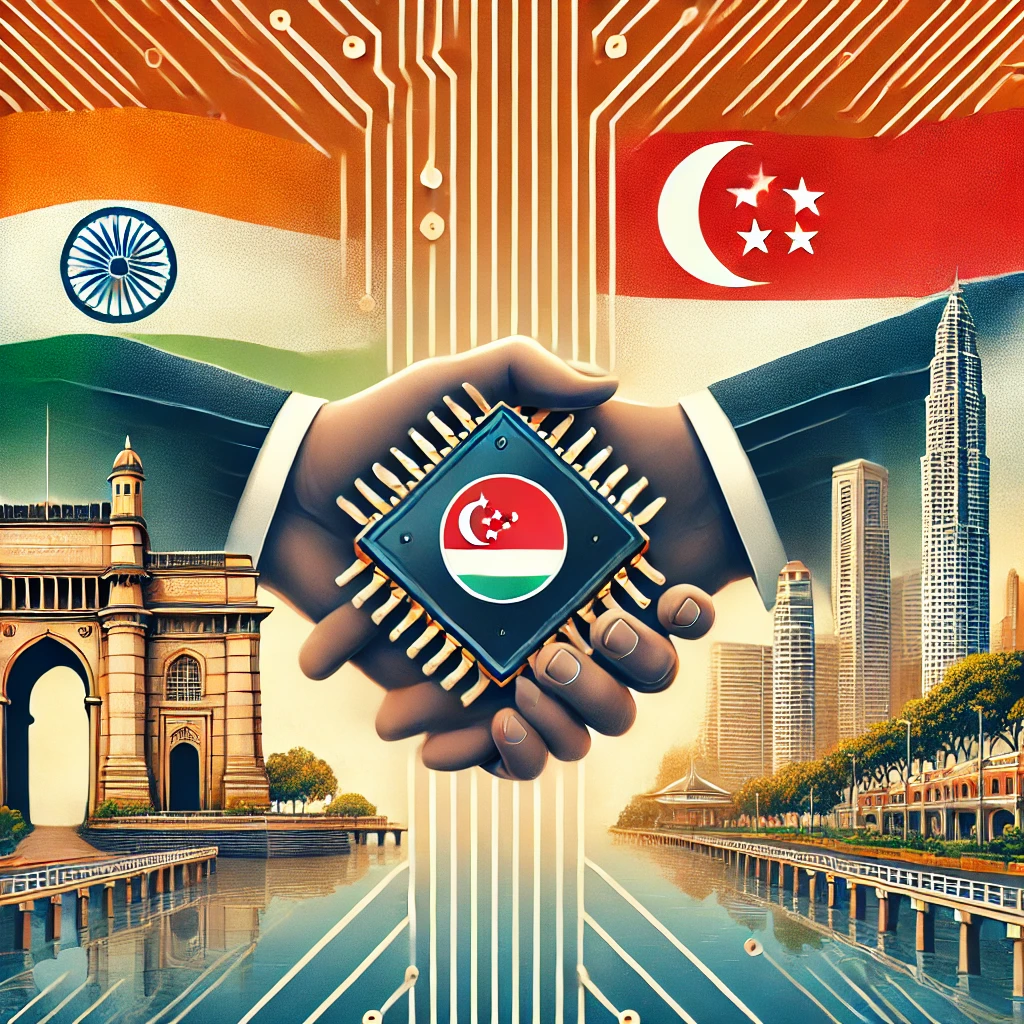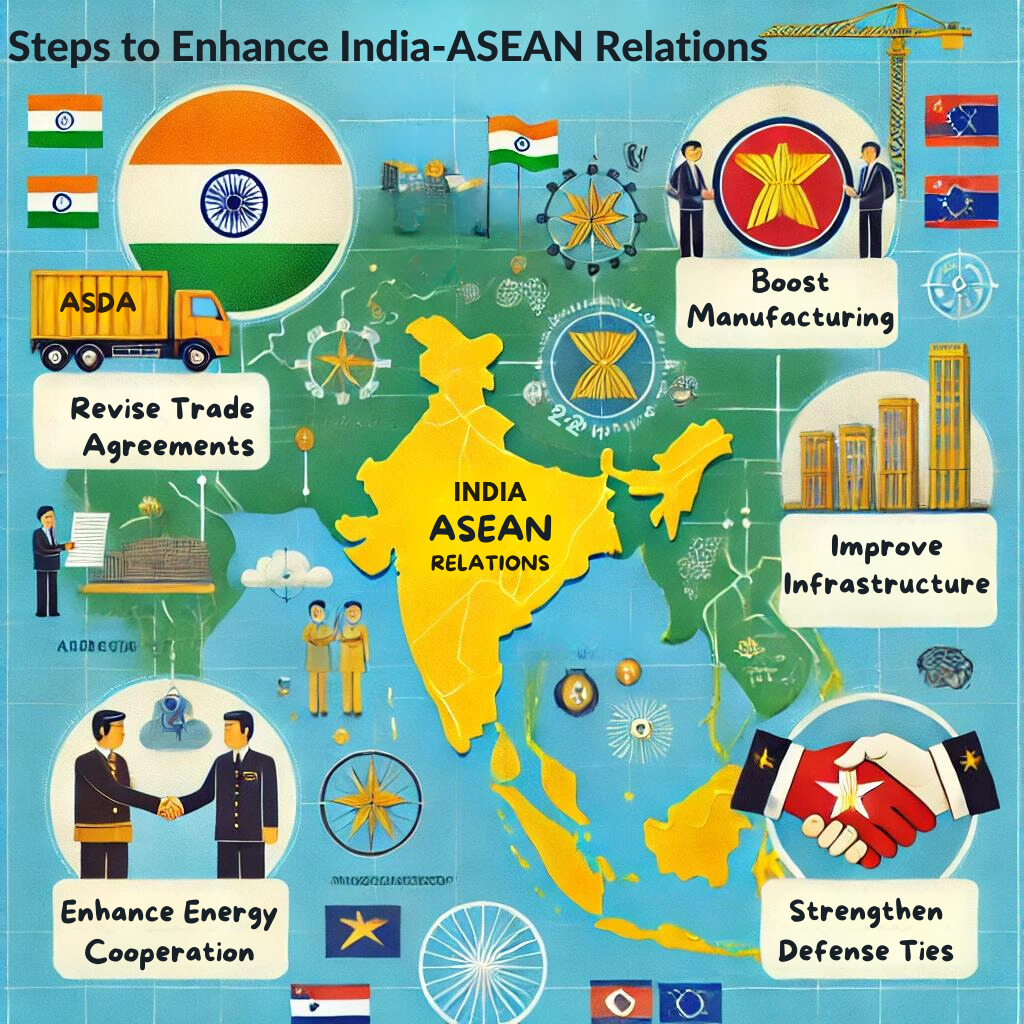The Indian Prime Minister’s upcoming visit to Singapore marks a significant moment in the evolving India-Singapore partnership. Both India and Singapore are expected to announce several agreements, including a key one on semiconductor ecosystem creation. Based on the “new anchors” identified during the recent India-Singapore Ministerial roundtable, the relationship is all set for a quantum leap. The economic salience is underlined by the fact that Singapore is India’s largest trade partner in ASEAN and the leading source of foreign direct investment. As India seeks to deepen its ‘Act East’ policy with further expansion in the Indo-Pacific, strengthening relations with Singapore assumes strategic importance.
| GS Paper | General Studies II |
| Topics for UPSC Prelims | ASEAN, Singapore, Indo-Pacific region, Act East policy, East Asia Summit, India-Myanmar-Thailand Trilateral Highway, Kaladan Multi-Modal Transit Transport Project, SAGAR, Supply Chain Resilience Initiative, Free Trade Agreement, South China Sea. |
| Topics for UPSC Mains | Significance of ASEAN for India, Key Concerns in India-ASEAN Relations. |
Origin of the Article
This editorial is based on “India, Singapore set to unveil MoU on cooperation in semiconductor ecosystem, ” published in Hindustan Times on 02/09/2024. The article discusses the Indian Prime Minister’s upcoming visits to Singapore and Brunei, highlighting the strengthening of bilateral ties with ASEAN and the identification of new areas for cooperation in fields like defense, technology, and sustainability.
Relevance for UPSC Students
Understanding this topic is crucial for UPSC students as it connects to the syllabus’s ‘India and its Neighborhood’ and ‘International Relations’ sections. It provides insights into India’s foreign policy, economic strategies, and regional security dynamics, which are essential for both the prelims and mains examinations. By studying this, aspirants can comprehensively understand India’s strategic partnerships and their implications.
Why in News
The Indian Prime Minister’s upcoming visit to Singapore is pivotal as it symbolizes the strengthening of India ASEAN relations, especially in the semiconductor sector. This visit highlights India’s strategic ‘Act East’ policy and its efforts to enhance ties with key ASEAN members, a recurring theme in UPSC GS Paper 2.
Indian Prime Minister’s Upcoming Visit to Singapore
The Indian Prime Minister’s upcoming visit to Singapore underscores the deepening of India-Singapore ties and their broader implications for ASEAN relations. This visit is expected to mark a significant milestone with several key agreements, including a crucial memorandum of understanding on creating a semiconductor ecosystem, being unveiled. Singapore’s role as India’s largest trade partner in ASEAN further emphasizes the economic importance of this visit.
Significance of the Visit
The Indian Prime Minister’s visit to Singapore is pivotal, as it is expected to result in the signing of about half a dozen agreements. These agreements, particularly in the semiconductor ecosystem, are set to bolster bilateral ties significantly. The visit also aims to enhance cooperation in defense, technology, and sustainability, building on the “new anchors” identified during recent ministerial roundtables.
Economic Ties
Singapore stands as India’s largest trade partner within ASEAN, highlighting its economic significance. The city-state’s role as a major source of foreign direct investment, with USD 11.77 billion invested in the last financial year, underscores the robust economic relationship. Strengthening these ties is crucial for India’s broader economic engagement with Southeast Asia.
Strategic Importance
Singapore’s strategic location and its pivotal role in India’s ‘Act East’ policy make this visit especially significant. As India seeks to expand its influence in the Indo-Pacific region, enhancing ties with Singapore becomes vital. This partnership is expected to play a crucial role in promoting regional stability and counterbalancing China’s growing influence.

Significance of ASEAN for India
ASEAN holds immense importance for India, encompassing economic, strategic, and cultural dimensions. The partnership has evolved significantly since 1992, growing into a Comprehensive Strategic Partnership in 2022. ASEAN’s economic powerhouse status, a strategic counterbalance to China, and cultural ties with India make it a crucial partner.
Historical Context and Elevation of Partnership
India ASEAN relations have evolved from a Sectoral Dialogue Partnership in 1992 to a Comprehensive Strategic Partnership in 2022. This journey reflects a steady deepening of ties, with milestones such as the 2002 Summit and the 2018 focus on maritime cooperation. The 30th anniversary in 2022 marked the elevation of this partnership to a new strategic level.
Economic Powerhouse-Gateway to Southeast Asian Markets
ASEAN represents a significant economic bloc for India, offering access to a vast market of over 650 million people and a combined GDP of USD 3.2 trillion. The ASEAN-India Free Trade Area has boosted bilateral trade to USD 110.39 billion in 2021-2022. Singapore, as India’s largest trade partner in ASEAN, underscores the economic vitality of this relationship.
Strategic Counterbalance
ASEAN’s strategic importance for India lies in its role as a counterbalance to China. Both entities share complementary visions for regional stability through India’s ‘Act East Policy’ and ASEAN’s ‘Outlook on the Indo-Pacific’. This strategic alignment is crucial in countering Chinese influence and promoting a rules-based international order.
Connectivity Catalyst
ASEAN is central to India’s vision of enhanced regional connectivity. Projects like the India-Myanmar-Thailand Trilateral Highway and the Kaladan Multi-Modal Transit Transport Project aim to physically integrate Southeast Asia. Digital connectivity initiatives, including 5G and cybersecurity cooperation, further strengthen these links.
Cultural Confluence
The cultural ties between India and Southeast Asia provide a unique foundation for soft power diplomacy. Initiatives like the ASEAN-India Artists’ Camp and Music Festival celebrate shared heritage, while the ASEAN-India Network of Universities enhances academic and cultural exchanges, bolstering people-to-people connections.
Technological Synergy
ASEAN’s digitalizing economies present significant opportunities for India’s IT sector. Collaborations in fintech, e-commerce, and artificial intelligence are crucial. Initiatives like the ASEAN-India Start-up Festival and the ASEAN-India Science and Technology Development Fund support joint research and technological innovation.
Maritime Security Collaboration
Maritime security is a key area of cooperation between India and ASEAN, particularly in the Indo-Pacific region. Joint efforts in piracy, illegal fishing, and disaster management align with India’s SAGAR doctrine. The inaugural ASEAN India Maritime Exercise in the South China Sea in May 2023 exemplifies this collaboration.
Energy Security and Sustainability
ASEAN’s energy resources offer opportunities for India to diversify its energy sources. Simultaneously, India’s expertise in renewable energy aligns with ASEAN’s sustainability goals. Joint efforts in clean energy technologies and sustainable development practices enhance energy security and combat climate change.
Supply Chain Resilience
Post-COVID-19, ASEAN has emerged as a key partner in building resilient supply chains. Cooperation in sectors like pharmaceuticals, electronics, and automobiles is crucial for creating robust supply chains. Initiatives like the Supply Chain Resilience Initiative aim to reduce dependence on China and enhance regional value chains.
Key Concerns in India ASEAN Relations
Despite strong ties, India ASEAN relations face several challenges. These include a significant trade imbalance, delays in infrastructure projects, navigating China’s influence, and regulatory hurdles. Addressing these concerns is crucial for further enhancing the partnership.
Trade Imbalance
India’s trade deficit with ASEAN has more than doubled since the implementation of the Free Trade Agreement in 2010. This imbalance is particularly pronounced in sectors like electronics and machinery. In the fiscal year 2022-2023, India’s exports to ASEAN were USD 44.04 billion, while imports reached USD 87.58 billion.
Infrastructure Connectivity
Physical infrastructure links between India and ASEAN remain underdeveloped. Key projects like the India-Myanmar-Thailand Trilateral Highway and the Kaladan Multi-Modal Transit Transport Project have faced significant delays. These challenges hamper trade flows and people-to-people connections.
Geopolitical Balancing – Navigating the China Factor
China’s growing influence in Southeast Asia poses a complex challenge for India-ASEAN relations. ASEAN member states are caught between Chinese economic inducements and security concerns. India’s efforts to position itself as a counterbalance to China, such as through the Quad Alliance, have met with mixed responses from ASEAN countries.
Regulatory Hurdles
Differences in regulatory standards create significant non-tariff barriers to trade and investment between India and ASEAN countries. Divergent food safety standards and certification processes hinder agricultural trade. The lack of mutual recognition agreements in professional services limits the movement of skilled professionals.
Why India Continues to Face Trade Deficit with ASEAN
India’s trade deficit with ASEAN is driven by several factors, including tariff asymmetry, non-tariff barriers, and manufacturing competitiveness. Additionally, India’s limited integration into regional value chains and barriers to services trade exacerbate the deficit.
Tariff Asymmetry
The ASEAN-India Free Trade Agreement (AIFTA) has led to asymmetric tariff reductions, disadvantaging India. While India has reduced tariffs on about 74% of its tariff lines for ASEAN countries, the latter have reciprocated for only about 56%. This imbalance contributes to the trade deficit.
Non-Tariff Barriers
ASEAN countries employ various non-tariff barriers that hinder Indian exports. These include complex regulatory requirements and stringent sanitary measures. For example, Indian pharmaceutical exports face lengthy registration processes, and agricultural products often struggle to meet ASEAN’s food safety standards.
Manufacturing Competitiveness
ASEAN countries like Vietnam and Thailand have developed robust manufacturing sectors with higher productivity levels than India. This competitiveness gap is evident in sectors like electronics and machinery. India’s relatively lower labor productivity and higher logistics costs contribute to this challenge.
Missing Link Regional Value Chain
India’s limited integration into ASEAN-centric regional value chains exacerbates the trade imbalance. ASEAN countries have positioned themselves as key nodes in global supply chains, particularly in the electronics and automotive sectors. India’s participation in these networks remains limited.
Services Trade Barriers
While India excels in services, barriers to services trade in ASEAN limit its ability to offset the goods trade deficit. Restrictions on the movement of professionals and lack of mutual recognition agreements for qualifications hinder India’s services exports.
Rules of Origin Exploitation
Weak rules of origin in the AIFTA allow non-ASEAN countries, particularly China, to route their exports to India through ASEAN. This ‘trade deflection’ exacerbates the trade deficit, particularly in sectors like electronics and machinery.
Measures to Enhance India ASEAN Relations
Several measures can be adopted to strengthen India-ASEAN relations. These include recalibrating the ASEAN-India Free Trade Agreement, enhancing infrastructure connectivity, boosting manufacturing competitiveness, enhancing energy cooperation, deepening strategic and defense cooperation, and aligning on climate change and sustainability.

Recalibrating the ASEAN-India Free Trade Agreement (AIFTA)
India should push for a comprehensive review of AIFTA to address the trade imbalance. Negotiating for more balanced tariff reductions, particularly in competitive sectors like pharmaceuticals and IT services, is crucial. Proposing phased tariff reductions on sensitive agricultural products could also be beneficial.
Enhancing Infrastructure Connectivity
Accelerating the completion of key connectivity projects like the India-Myanmar-Thailand Trilateral Highway is essential. Proposing a comprehensive “Connectivity Master Plan” aligned with ASEAN’s Master Plan on Connectivity 2025 can significantly boost trade and digital connectivity.
Boosting Manufacturing Competitiveness
To address the manufacturing competitiveness gap, India should focus on sector-specific interventions. Extending the Production Linked Incentive (PLI) scheme to more industries and proposing joint manufacturing initiatives with ASEAN countries can enhance regional value chain integration.
Enhancing Energy Cooperation
Proposing a comprehensive “ASEAN-India Energy Partnership” focusing on energy security and clean energy transition is vital. Joint research on renewable energy technologies and knowledge sharing on energy efficiency can support ASEAN’s sustainability goals and diversify India’s energy sources.
Enhancing Strategic and Defense Cooperation
India should deepen its strategic engagement with ASEAN, particularly in maritime security. Offering capacity-building assistance in areas like maritime domain awareness and anti-piracy operations can enhance regional security cooperation. Joint defense production initiatives can also strengthen strategic trust.
Aligning on Climate Change and Sustainability
Proposing an “ASEAN-India Green Partnership” focusing on climate change mitigation and renewable energy is essential. Technology transfer in areas like solar energy and joint research on climate-resilient agriculture can address shared environmental challenges.
How India Can Leverage Singapore to Enhance Its Relations with ASEAN
Singapore can serve as a pivotal partner for India in enhancing its relations with ASEAN. Leveraging Singapore’s strategic location, economic gateway status, and expertise in maritime security and technology can significantly bolster India’s regional engagement.
Economic Gateway
Singapore’s strategic location and status as a financial hub make it an ideal economic gateway for India. Using Singapore as a base for expanding into Southeast Asian markets and leveraging the Comprehensive Economic Cooperation Agreement (CECA) can boost trade and investment flows.
Maritime Security Cooperation
Given Singapore’s strategic location at the Malacca Strait, expanding joint naval exercises like SIMBEX to include other ASEAN nations can enhance regional maritime cooperation. Collaborating on maritime security initiatives within ASEAN can promote regional stability.
Technology and Innovation Hub
Partnering with Singapore in emerging technologies like blockchain and AI can align with India’s digital ambitions. Using Singapore as a testbed for Indian tech innovations before scaling them across ASEAN can enhance technological collaboration.
Supply Chain Resilience
Collaborating with Singapore on supply chain resilience initiatives can enhance regional connectivity. Leveraging Singapore’s logistics expertise to ensure the free flow of essential goods and services during crises can strengthen regional supply chains.
PESTEL Analysis
| Political: The partnership between India and Singapore is strategic. The Indian Prime Minister reinforced ties in the region, where geopolitical tensions, most significantly with China, stir alliances. Its Act East Policy continued to align with efforts toward regional stability and influence in light of diplomatic and defense collaboration. Economic: It views ASEAN as a very significant economic bloc, with Singapore being a key partner. The agreements on semiconductor ecosystems and joint technological ventures reflect efforts at redressing the trade imbalance indicated by the deficit in electronics and machinery. Improvement in the trade agreement and promotion of manufacturing through schemes like PLI is the way toward economic reciprocity. Social: Shared historical and cultural relations indeed make soft power diplomacy a resource for goodwill throughout ASEAN. Cultural affinity facilitates cooperative ventures that bring together the people-to-people links of the community, and social bonds that are lifeblood to sustainable diplomatic and economic relationships. Technological: In fintech, e-commerce, AI, especially semiconductor development with Singapore technological collaboration in general is important. It can trigger innovation and lay the bedrock for digital transformation to take place in the region. Environmental: Proposals for the ASEAN-India Energy Partnership with a special focus on renewable sources of energy underline the ecological constituent of the relations. Cooperation in green technology, in general, and ecologically friendly practice, in particular, is badly needed as viewed from both regions’ severe environmental problems. Legal: One of the challenging features of trade and investment has been regulatory barriers. The differences in standards, as well as the pace of basic infrastructure projects like the India-Myanmar-Thailand Highway, also indicate that more streamlined regulations and a better legal framework would facilitate easier cooperation in project implementation. |
Conclusion
The strategic engagement by India with ASEAN, as underlined by the growing partnership with Singapore, underlines a basic shift toward more extensive economic, technological, and security cooperation. While India leverages the position and expertise of Singapore to enhance its regional footprint, ongoing commitment toward strengthening ASEAN ties portends substantial mutual benefits. Correcting the trade imbalance and expanding cooperation in identified priority sectors will hold the key to realizing the full potential of this dynamic relationship.
| UPSC Civil Services Examination, Previous Year Questions (PYQs) Mains Q. Discuss the impediments India is facing in its pursuit of a permanent seat in the UN Security Council. (GS Paper II, 2015) Q. The South China Sea has become a flashpoint for regional tensions involving major powers. Analyze the impact of the South China Sea disputes on India’s strategic interests and its relations with ASEAN. |

